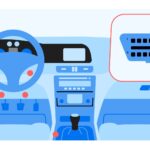Adjusting your vehicle’s speedometer might seem necessary after changing tire sizes. A common question is whether an OBD2 scanner can handle this task. While OBD2 scanners are powerful diagnostic tools, they typically can’t directly adjust the speedometer setting. Let’s explore why and what alternatives are available.
OBD2 scanners excel at retrieving diagnostic trouble codes (DTCs), monitoring engine performance, and accessing various sensor data. However, modifying the speedometer calibration usually requires specialized software and tools designed to interface with the vehicle’s electronic control module (ECM) or powertrain control module (PCM). These modules control critical functions, including fuel injection, ignition timing, and transmission shifting, in addition to the speedometer. Altering these settings without the proper equipment and knowledge can have unintended consequences.
Why might your speedometer need adjustment? Changing tire size, particularly going from a smaller to a larger diameter, affects the distance traveled per tire revolution. This discrepancy leads to inaccurate speed readings. A 3% difference in tire size, as mentioned in the original post, can result in a noticeable speedometer error.
While a 10% speedometer inaccuracy seems excessive with only a 3% tire size difference, it’s possible. Previous modifications by the former owner, like changing the rear end gear ratio, could contribute to this larger discrepancy. As the original post mentions, checking the gear ratio and the speed sensor itself are good steps to identify any prior alterations. Physical inspection, counting the teeth on the gears, and comparing them to factory specifications can reveal if non-standard gearing is present.
Addressing speedometer inaccuracies usually involves professional recalibration. Dealerships and specialized automotive shops possess the necessary tools and expertise to adjust the ECM/PCM for accurate speed readings. This process often involves connecting to the vehicle’s diagnostic port with specialized software to reprogram the speedometer based on the new tire size or gear ratio. For significant speedometer discrepancies, investigating potential modifications to the vehicle’s drivetrain is crucial.
So, while an OBD2 scanner can’t directly adjust your speedometer, it can be valuable for diagnosing other potential issues and monitoring your vehicle’s overall health. For accurate speedometer calibration after tire or gear ratio changes, consult a qualified mechanic or dealership. They have the necessary equipment and expertise to ensure accurate speedometer readings and maintain the vehicle’s proper functioning. Remember, accurate speedometer readings are vital for safety, fuel efficiency, and avoiding potential legal issues.
